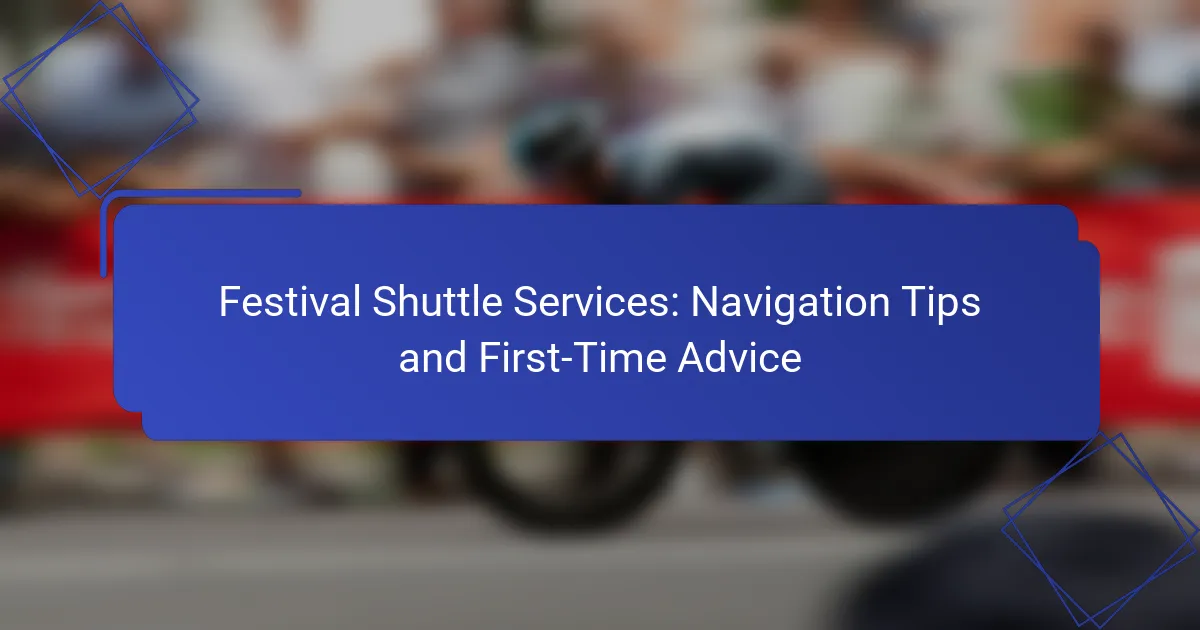Choosing the right transportation for festivals can greatly enhance your experience, with options ranging from public transit to rideshare services and personal vehicles. Each mode of transport offers unique benefits, such as cost savings and reduced congestion, but also comes with considerations like parking availability and safety. Understanding these factors will help you make an informed decision that suits your needs and maximizes your enjoyment of the event.
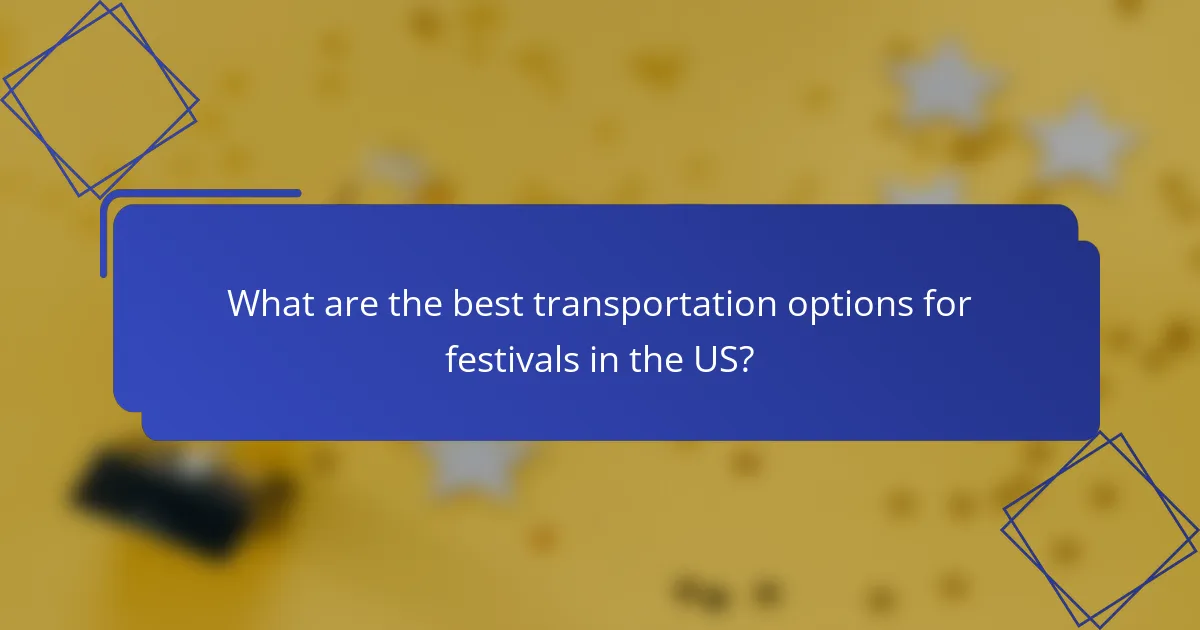
What are the best transportation options for festivals in the US?
The best transportation options for festivals in the US include public transportation, rideshare services, festival shuttles, personal vehicles, and bicycles or walking. Each option has its own benefits and considerations, making it essential to choose based on convenience, cost, and accessibility.
Public transportation systems
Public transportation systems, such as buses and trains, are often a cost-effective way to reach festivals. Many cities offer discounted fares or special routes during major events, making it easier to avoid traffic and parking hassles.
Check local transit schedules in advance, as service may be limited during peak festival hours. Consider purchasing a day pass if you plan to use public transport multiple times, as this can save you money.
Rideshare services like Uber and Lyft
Rideshare services like Uber and Lyft provide a convenient option for festival-goers who prefer door-to-door service. These services can be especially useful if public transportation is not available or if you are traveling with a group.
Keep in mind that surge pricing may apply during busy festival times, so it’s wise to compare estimated fares before booking. Also, be aware of designated pickup and drop-off zones at the festival to avoid delays.
Festival shuttles
Many festivals offer dedicated shuttle services that transport attendees from key locations, such as hotels or public transport hubs, directly to the event. These shuttles can be a reliable way to avoid parking challenges and long walks.
Check the festival’s official website for shuttle schedules, pricing, and pickup locations. Booking in advance is often recommended to secure your spot, especially for popular events.
Personal vehicles
Using a personal vehicle to attend a festival provides flexibility and convenience, especially if you are traveling with friends or family. However, parking can be a significant consideration, as many festivals have limited spaces or charge high fees.
Arrive early to secure a good parking spot and consider carpooling to reduce costs and environmental impact. Familiarize yourself with the festival’s parking policies to avoid fines or towing.
Bicycles and walking
Bicycles and walking are eco-friendly options for festival transportation, particularly if you live nearby. Many festivals encourage biking by providing bike racks and may even offer incentives for those who arrive on two wheels.
If you choose to walk, plan your route ahead of time to ensure safety and convenience. Wear comfortable shoes and stay hydrated, especially if the weather is warm.
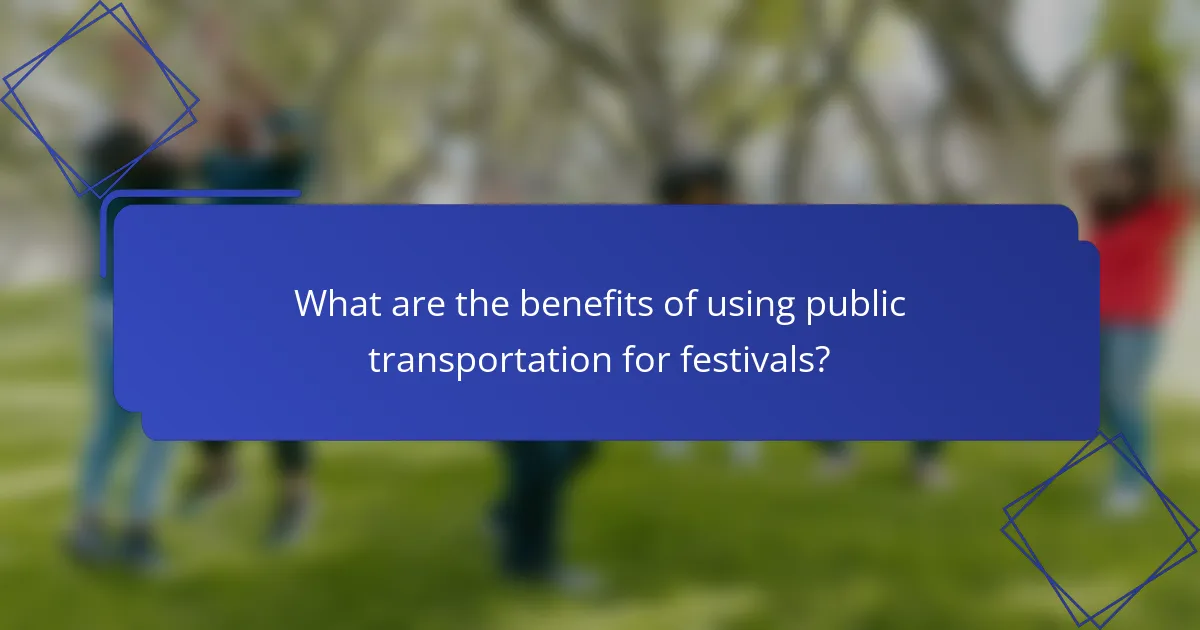
What are the benefits of using public transportation for festivals?
Using public transportation for festivals offers several advantages, including cost savings, reduced traffic congestion, and environmental benefits. These factors make it a practical choice for festival-goers looking to enhance their experience while minimizing hassle.
Cost-effective travel
Public transportation is often a more affordable option compared to driving and parking. Many cities offer discounted fares for festival attendees, which can significantly lower travel expenses. For instance, a round-trip bus or train ticket may cost only a fraction of what parking fees can amount to during busy festival days.
Additionally, using public transport can eliminate costs associated with fuel and vehicle maintenance. By choosing this option, festival-goers can allocate their budget towards enjoying food, merchandise, and other activities at the event.
Reduced traffic congestion
Public transportation helps alleviate traffic congestion during festivals, making travel smoother for everyone. With large crowds attending events, roadways can become heavily congested, leading to delays and frustration. Buses and trains can transport many people at once, reducing the number of individual vehicles on the road.
Moreover, many public transport systems implement special routes or additional services during festivals, ensuring that attendees can reach their destination efficiently. This coordinated effort can lead to a more enjoyable experience, allowing festival-goers to focus on the event rather than the journey.
Environmental benefits
Choosing public transportation for festivals contributes to lower carbon emissions and a smaller ecological footprint. Mass transit systems are generally more energy-efficient than individual cars, especially when transporting large groups of people. This shift helps reduce air pollution and conserves energy resources.
Furthermore, many cities are increasingly investing in greener public transport options, such as electric buses and trains. By opting for these environmentally friendly modes of travel, festival attendees can support sustainability initiatives while enjoying their favorite events.
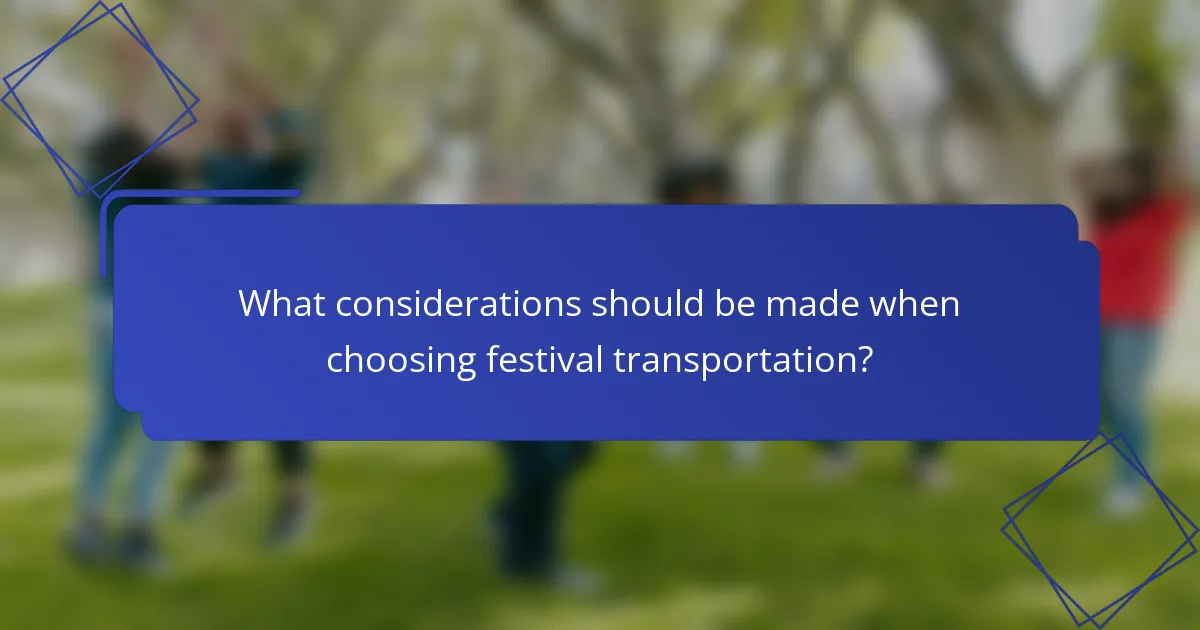
What considerations should be made when choosing festival transportation?
When selecting transportation for a festival, key considerations include the distance to the venue, parking availability, and safety and security. Each of these factors can significantly impact your overall experience and convenience during the event.
Distance to the venue
The distance to the festival venue is crucial when planning transportation. If the event is far from your accommodation or home, you may want to opt for public transport, rideshare services, or even overnight stays nearby. Consider travel times and how they might affect your schedule, especially if you want to arrive early or leave late.
For shorter distances, walking or biking could be viable options, allowing you to avoid traffic and parking hassles. Always check local maps and transport schedules to gauge the best routes and modes available.
Parking availability
Parking availability can vary greatly depending on the festival location. Some venues offer ample parking, while others may have limited spaces or require permits. Researching parking options in advance can save you time and frustration on the day of the event.
If you plan to drive, consider arriving early to secure a good spot. Alternatively, using public transport or rideshare services can eliminate the need for parking altogether, allowing you to focus on enjoying the festival.
Safety and security
Safety and security are paramount when choosing festival transportation. Assess the safety of the transportation options available, especially if traveling at night. Public transport systems may have specific safety measures in place, while rideshare services often provide tracking features.
Additionally, consider the security of your belongings during transit. Use bags that can be securely closed and avoid carrying large amounts of cash. Familiarize yourself with emergency contacts and procedures for the festival to ensure a safe experience.
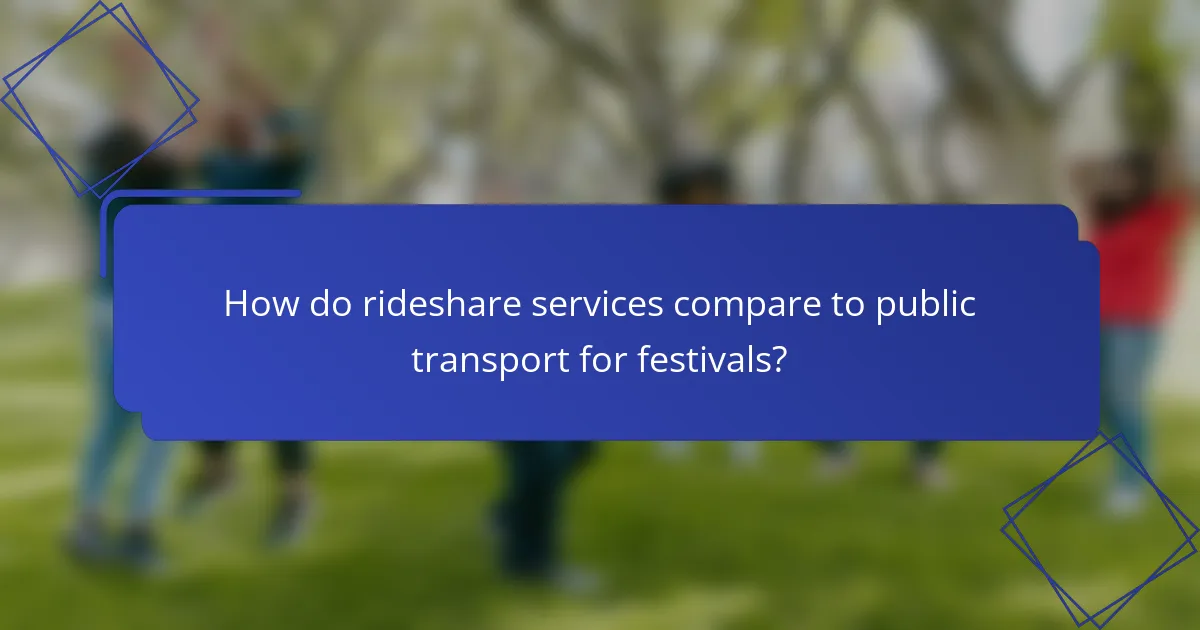
How do rideshare services compare to public transport for festivals?
Rideshare services generally offer more convenience and flexibility compared to public transport for festival-goers. While public transport can be cost-effective, rideshare options provide a tailored experience that can save time and reduce hassle.
Convenience and flexibility
Rideshare services like Uber or Lyft allow users to request a ride directly from their location, making them highly convenient for festival attendees. This flexibility means you can leave the event whenever you choose, without worrying about fixed public transport schedules.
Public transport, on the other hand, operates on set routes and timetables, which may not align with festival hours. This can lead to longer wait times or the need to plan your departure in advance, limiting spontaneity.
Cost differences
Rideshare fares can vary significantly based on demand, especially during peak festival times, often resulting in surge pricing. While a typical ride might cost between $10 to $30, during busy periods, prices can increase by 50% or more.
Public transport usually offers a more stable pricing structure, with single fares often ranging from $2 to $5. However, consider additional costs like parking fees if you drive to a transit station, which can add up.
Availability during peak times
During major festivals, rideshare availability can be limited due to high demand, leading to longer wait times. It’s advisable to book your ride in advance or expect delays, especially during event start and end times.
Public transport typically has a more consistent schedule, but services may be crowded and less frequent during peak festival hours. Check local transit schedules to avoid long waits and ensure you have a reliable way to get to and from the event.
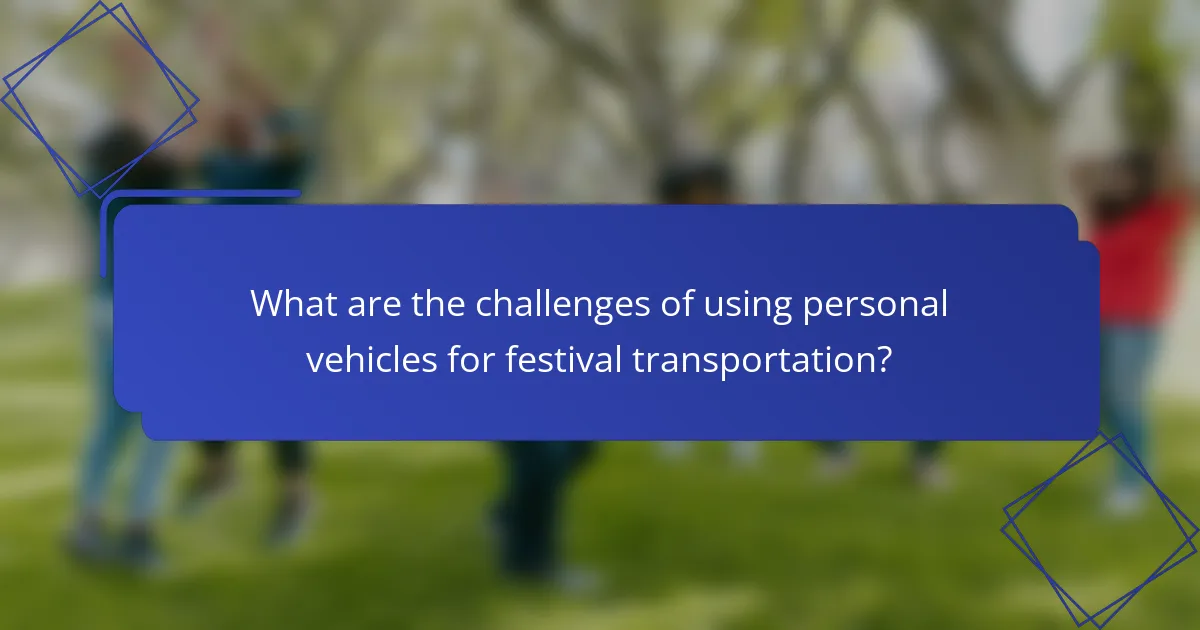
What are the challenges of using personal vehicles for festival transportation?
Using personal vehicles for festival transportation can lead to several challenges, including limited parking options and significant traffic delays. These issues can detract from the overall festival experience and require careful planning to navigate effectively.
Parking limitations
Many festivals have restricted parking availability, often leading to full lots well before the event begins. Attendees may need to park far from the venue, increasing walking distances and time spent getting to the festival entrance.
Some festivals offer designated parking areas that may require advance reservations or additional fees. It’s advisable to check the festival’s website for parking guidelines and consider arriving early to secure a spot.
Traffic delays
Heavy traffic is common during festival times, with many attendees arriving simultaneously. This can result in long wait times both on the way to the venue and when leaving after the event.
To mitigate traffic issues, consider carpooling with friends or using alternative transportation methods, such as shuttles or public transit. Planning to arrive during off-peak hours can also help reduce delays and enhance your festival experience.



